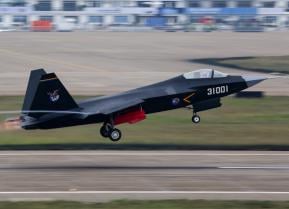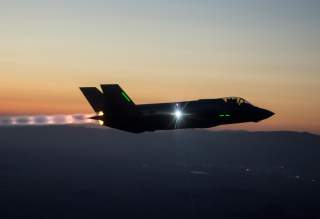StormBreaker: The F-35s New Killer Weapon
StormBreaker, described as a key element of Block 4, is a new air-dropped weapon able to destroy moving targets in all kinds of weather conditions at ranges greater than 40-miles, Air Force and Raytheon officials said.
The Air Force has begun early testing, software development and weapons integration for its upcoming Block 4 variant of the F-35 Joint Strike Fighter, an emerging model intended to give the multi-role fighter a new dimension of weapons and attack mission possibilities, service leaders said.
The new version, to emerge in the early 2020s, will add new long-range precision-tracking weapons such as the newly named StormBreaker weapon - previously called the Small Diameter Bomb II.
"StormBreaker™ successfully completed Developmental Testing and the Government Confidence Testing phase earlier this year. StormBreaker demonstrated all operating modes, the capability to send, receive, and process data-link messages via both link-16 and UHF, Tara Wood, an official with Raytheon's weapons development unit, told Warrior Maven.
The Air Force and F-35 weapons integration office are also integrating a new upgraded AIM-9x air to air missile, which will enable pilots to attack enemy fighters "off-boresight," a term which refers to an increased target envelope.
An "off-boresight" AIM-9s will give pilots an ability to target and destroy enemies behind and to the sides of the F-35, Joe Dellavedova, an official with the Pentagon's F-35 Joint Program Office, told Warrior Maven in an interview.
“The next step for F-35 weapons integration will be to address the weapon requirements within Block 4. Integration of the Small Diameter Bomb II has already begun, and flight test is scheduled to start as early as 2019,” Capt. Emily Grabowski, Air Force Spokeswoman, told Warrior Maven in a statement a short time ago.
StormBreaker - Small Diameter Bomb II
StormBreaker, described as a key element of Block 4, is a new air-dropped weapon able to destroy moving targets in all kinds of weather conditions at ranges greater than 40-miles, Air Force and Raytheon officials said.
Wood further explained that StormBreaker detects, classifies, and tracks a wide array of targets, both moving and stationary. It also has an ability to prosecute moving targets through adverse weather conditions. StormBreaker™ is currently in Operational Test, Wood said.
GPS and laser-guided weapons such as Joint Direct Attack Munitions have been around for decades, however, they have primarily been designed for use against fixed or stationary targets. StormBreaker has already completed a series of wind tunnel tests.
While the Air Force currently uses a laser-guided bomb called the GBU-54 able to destroy moving targets, the new SDB II will be able to do this at longer ranges and in all kinds of weather conditions. In addition, the SDB II is built with a two-way, dual-band data link which enables it to change targets or adjust to different target locations while in flight, Raytheon developers told Warrior Maven.
Operational Testing will utilize the weapon in real world conditions in operationally relevant scenarios, she explained.
A key part of the SDB II is a technology called a “tri-mode” seeker — a guidance system which can direct the weapon using millimeter wave radar, uncooled imaging infrared guidance and semi-active laser technology.
Raytheon weapons developers say the tri-mode seeker provides a range of guidance and targeting options typically not used together in one system. Millimeter wave radar gives the weapon an ability to navigate through adverse weather, conditions in which other guidance systems might encounter problems reaching or pinpointing targets.
Imagining infrared guidance allows the weapon to track and hone in on heat signatures such as the temperature of an enemy vehicle. With semi-active laser technology, the weapon can be guided to an exact point using a laser designator or laser illuminator coming from the air or the ground, Raytheon officials told Warrior.
One Raytheon SDB II developer told Warrior in a previous interview that “the millimeter wave radar turns on first. Then the data link gives it a cue and tells the seeker where to open up and look. Then, the weapon can turn on its IR (infrared) which uses heat seeking technology.”
The SBD II is engineered to weigh only 208 pounds, a lighter weight than most other air dropped bombs, so that eight of them can fit on the inside of an F-35 Joint Strike Fighter, Raytheon officials explained.
If weapons are kept in an internal weapons bay and not rested on an external weapons pod, then an aircraft can succeed in retaining its stealth properties because the shapes or contours of the weapons will not be visible to enemy radar.
Recommended: What Will the Sixth-Generation Jet Fighter Look Like?
Recommended: Imagine a U.S. Air Force That Never Built the B-52 Bomber
Recommended: Russia's Next Big Military Sale - To Mexico?
Recommended: Would China Really Invade Taiwan?
About 105 pound of the SDB II is an explosive warhead which encompasses a “blast-frag” capability and a “plasma-jet” technology designed to pierce enemy armor, Raytheon officials explained.
The SDB II also has the ability to classify targets, meaning it could for example be programmed to hit only tanks in a convoy as opposed to other moving vehicles. The weapon can classify tanks, boats or wheeled targets, Raytheon officials added.s, this will no longer remain the case.
StormBreaker, which is also being integrated on the F-15E, is carried on the BRU-61, a 4 place miniature munitions rack that fits in the F-35’s internal weapons bays. The weapons will be integrated on the F/A-18E/F and F-35B for the Navy and Marine Corps before the F-35A and F-35C, developers explained.
"StormBreaker™ uses Universal Armament Interface protocol to make the weapon/aircraft interface compatible with a wide range of aircraft, including F-35," Wood added.
AIM-9X
Designed as part of the developmental trajectory for the emerging F-35, previous test-firings of the AIM-9X were intended to further the missile's ability to demonstrate this “off-boresight," attack technology. Previous test data and observers have confirmed the F-35 identified and targeted the drone with its mission systems sensors, passed the target ‘track’ information to the missile, enabled the pilot to verify targeting information using the high off-boresight capability of the helmet mounted display and launched the AIM-9X from the aircraft to engage the target drone, a statement from the F-35 JPO said.
F-35 to 2070
The current consensus among senior Pentagon weapons developers holds that, at the moment, the F-35 is the most capable 5th generation plane in the world. Maintaining this edge, however, is anticipated to quickly become more and more difficult now that both Russia and China are building 5th-gen stealth fighters.
“Block 4 is important with the national defense strategy to make sure we are modernizing the plane to keep it dominant on the battlefield. We are close to knowing the strategy for how to go after it,” Dr. Will Roper, Assistant Secretary of the Air Force for Acquisition, Technology and Logistics, told a group of reporters earlier this year.
While the applied impact of Block 4 will incorporate a range of mission-expanding technologies, much of the ongoing preparation work is in the realm of software development, Roper said.
“The physical pieces of the plane are moving in a good direction. Most of what we have left to do is software. The department (DoD) has not historically been good at software development. That will take a little longer. I cannot imagine building anything for the Air Force that is not software intensive,” Roper said.
The Block 4 initiative is part of a long range trajectory planned for the F-35 described by Pentagon developers as C2D2 - Continuous Capability Development and Delivery. The idea, officials say, is to position the multi-role fighter such that it can consistently accommodate new weapons, stealth materials, sensors and guidance technology as it becomes available
“We own today’s fight,” said Lt. Col. Tucker Hamilton, F-35 Test Director, Edwards AFB, told reporters earlier this year. However, Tucker went on to say that, in the absence of aggressive modernization, sustainment and various improvement efforts.
This first appeared in Warrior Maven here.


